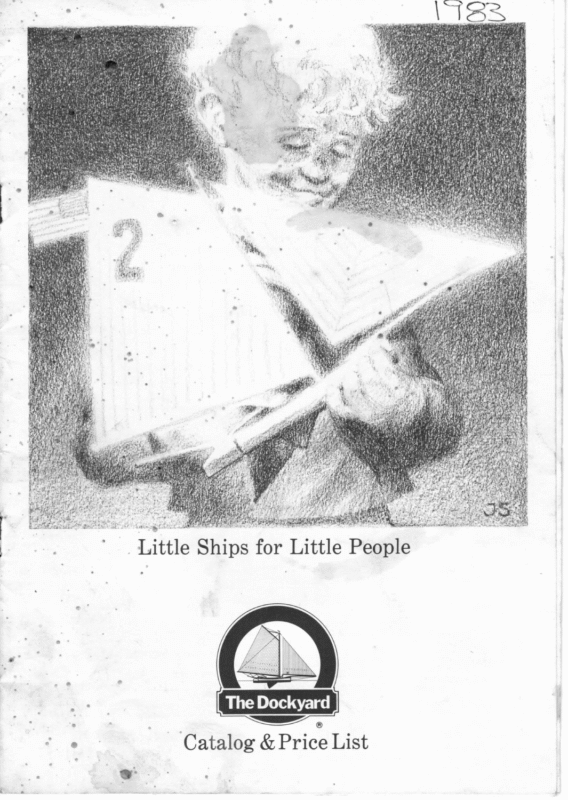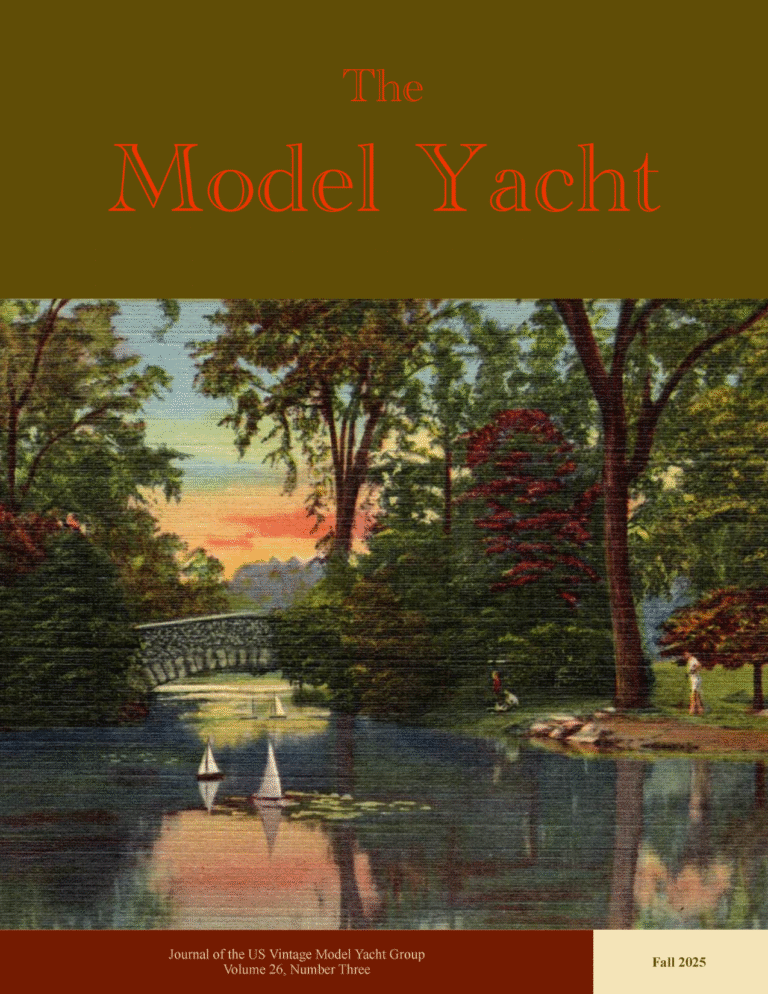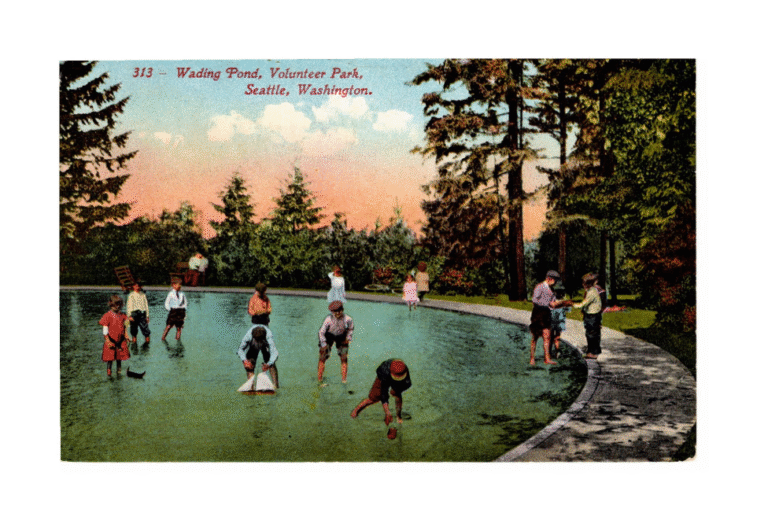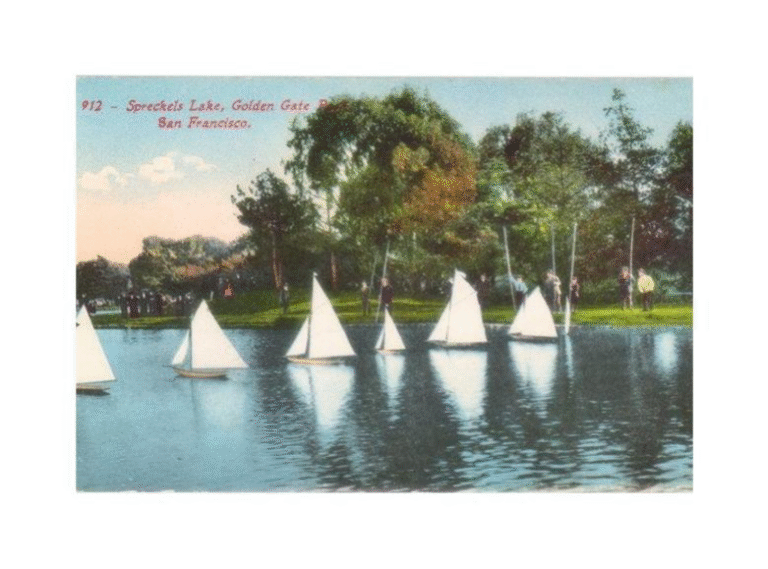3 7 Little Ships for Little People Sth | * he 4 > * . i? . = . .* . . .. a. ” @ . * * » – e ® = > ° ® = ° « . ° e e ry . ®
| “How very little since things were made Things have altered in the shipwright’s trade” Rudyard Kipling SOME CREDITS: We wish to thank Jim Sollers of Camden, Maine for the wonderful cover illustration. Our friend Kip Brundage, also of Camden, for all his time and effort in the photographs. Special thanks to Beverly Curry without whose skill and patience, our little ships would never have sailed. Last but not least to Mary Eliza Wengren for editing this text. And quiet thanks to Tauni and Suzanne for putting up with this whole venture. Printed in the United States of America. Copyright, The Dockyard Inc., 1981 South Freeport, ME 04078
A word about our boats Our boats are constructed of wood, paint, fabric and brass, all traditional boatbuilding materials. Each boat is made one at a time by hand, from the rough carving to the finely sanded and painted hull. Spars not dowels Nothing ruins the appearance of a little vessel more than a dowel stuck in the deck to represent the mast. Our hardwood spars are turned with a proper taper over their whole length and are finished with stain and varnish in bristol fashion. No such thing as perfect We constantly strive for and them bright. Nothing beats the rich patina of well-polished brass, or lasts as long. Traditional achieve a high degree of finish. sailing craft But since each boat is handmade, no two are ever exactly alike. Wet sails cotton vs. Dacron Sails made of a porous material like cotton will soak up a great Our boats are all semi-scale. Their Occasionally there will be some lines are based on actual small imperfection. Like Chinese traditional vessels, with some art, it’s up to you to find the flaw. changes made to make them If your orientation is high tech perform better in small scale. deal of water, which adds considerable weight and and you respond to the slick finish They are toys built to last. They of plastic or fiberglass, we suggest are made to be used and enjoyed adversely affects the performance of a boat. you seek the many alternative by kids of all ages. We like to think sources available. that we Our sails are impervious to water and come up almost dry after a good soaking. All jibs and mainsails are hand cut, numbered and sewn from the best Dacron sailcloth available today. The headstay is sewn into the jib and is made of a very tough %, inch leech line. The sails take a great shape. They will not sag or wrinkle. They will outlast and outperform cotton sails. Small boat maintenance All that is required to maintain your boat after a sail is a good rinse in clean fresh water to remove salt or algae accumulation. If the sails need freshening up after many voyages, a careful scrub with warm water and mild soap should do it. Because the small parts or fittings are made of solid brass, they will tarnish with time. A little brass polish vigorously applied with a soft cloth will keep “build them the way they used to”.
Knockabout Our smallest yacht and a good beginners boat, this little knockabout will sail quite smartly with sufficient breeze under the right conditions. It sports a stout round hull for flotation and a full keel for stability. It is equally at home in a bathtub, pool or small pond. Bright yellow solid wood hull with green bottom paint and a red boot top. Comes rigged with a tapered hardwood mast and boom fitted with a jib and numbered mainsail. Solid brass fittings. Overall length: 8, inches height: 10 inches width: 4 inches The rig is unusual in that the mainsail has pockets for both mast and boom, minimizing the need for complicated rigging. Travels well in suitcase or small bag. Unsinkable.
Sandbagger The most common of the machines, they became known as in the east coast fisheries was the “sandbaggers” and raced for large sandbagger. A broad, shoal draft stakes. By the 1870’s, sandbaggers centerboarder, it had a wide, were considered the national square stern and a good deal of “type” of yacht, distinctly dead rise. The midsection was a wide, shallow “v”. American. The style of hull and rig Overall length: 22% inches height: 18 inches width; 6% inches Wooden stand. As out-and-out racing sloop-rigged small boat types used Our completely finished, working, semi-scale boat features influenced the design of both a hand rubbed and painted solid yachts and workboats for over wood hull. Nicely tapered, stained forty years. Developed in the and varnished hardwood spars. A 1830’s when the centerboard had gained wide acceptance, the rig brass centerboard, working brass was a simple jib and mainsail with rudder and brass fittings. Handmade and numbered a long gaff and a very long boom, sails of real sailcloth hold a good no shrouds, and only a single shape and outlast cotton. Of robust headstay. The large jib was set on construction, this little vessel a long, hogged down bowsprit. should stand up to years of service. These boats were very fast Ready to sail and unsinkable. sailers with enormous rigs. To keep them “on their feet” in a fresh breeze required sandbag ballast which had to be piled on the weather rail by the crew.
English Channel Cutter CUTTER (A) Overall length: 22 inches, including bowsprit and boom height: 23 inches, including the full keel width: 3Y, inches Cherry wood cradle. CUTTER (B) Overall length: 23” hull measurement only height: 5” width: 4” mast: 27%, La Bow sprit & boom 36” rule, which handicapped racing in the 1870’s, encouraged the British to build very narrow yachts witha deep draft and ballasted keels. With such great depth to width ratios, these cutters were quite seaworthy and almost impossible to capsize. They carried a great expanse of sail and were very fast. In contests here in America, the visiting English boats beat the best of our shoal draft sloops repeatedly. Our little cutter has a hand finished and painted solid wood hull which is drilled out to reduce weight and covered with a watertight deck. A false keel is fitted to the bottom so the boat can be set on a cradle for display. For sailing, a weighted keel is bolted to the false keel, giving the boat Fittings of brass. A good sailer in a reasonable sea with a stiff breeze. ee great depth. The Thames measurement great stability under sail. Our keel weights are cast in marine bronze, in three different sizes. One comes with the boat; the others can be purchased separately to suit your needs. Cutter style rig with a jib, foresail, topsail and gaff mainsail. Hardwood spars which are tapered, stained and varnished. fk If the American “type” was a shoal draft centerboard sloop, then the English “type” of the same period surely would be the channel cutter. It was a boat of little beam and
Recollections It has been some time now. As I recall, the conversation started with a brief description of happy The boats, as such, changed We understand it was a gift to the quickly from boards with sticks and bandana sails to clean hulled gentleman’s grandson, in the hope that it too might provide memories in some future time. childhood memories of many vessels outfitted with complete years ago. rigs. They were handsome little It seems there was a near perfect boat pond. A group of regulars frequented it on lazy sailers. summer evenings to sail boats and or the uncle who made it for him. roughhouse. The regulars would get pretty serious about the small boats they sailed, and it wasn’t long before dads, uncles and friends were enlisted to help with the making of them as the competition stiffened. The recipient of one of these boats never forgot that magic time Even with the passage of years, the memory never dimmed. Now we were being asked to duplicate such a boat from recollections. A rough sketch, measurements and impressions were recorded. Work started. The completed boat was well received. May we build one for you?
+. Half Hull Models Seen occasionally on the walls of be no allowance or concern for errors in carving two sides exactly half hulls have been appreciated and collected for years. They are valued both for their stark beauty as works of art and for their role as the same. old boat shops and in museums, historic artifacts. Few people know that beyond having a collectible aesthetic value, the half hull was a critical tool in the design and construction of a vessel. It was the link between the concept of a boat in someone’s mind and the three dimensional execution of that idea. Once carved, the idea could be seen. Corrections could be made in its shape, and the designer could judge how successful it would be IVT a eer Why only half a boat? Though a boat is a mass of very complex curves from stem to stern, it is always the same shape on both sides. Taking the measurements (lofting) from one half ensures that they will be the same on both halves. There need as a vessel. Also available, large scale half hulls to order, for over barn and garage doors or any exterior wall. When completed, the half hull model provided all the important measurements necessary for the builder to complete his task. It was in effect a three dimensional blueprint from which to work. The Dockyard offers custom half hulls which are hand carved to order. We will do your boat if you have the lines, or you can choose one of the historic vessels in our files. Each of our half hulls is mounted on a mahogany plaque with a brass name plate. Write us your special requests. We will answer by return mail.
Points of sail In the following illustrations, the lines on the water represent the BROAD REACH direction of the wind as if you were facing into it. Note the different angles the boat has taken relative to the wind lines and what each of these positions is called. This will tell you the different points of sail and show what course your boat would take on each. RUN or RUNNING BEFORE THE WIND Luffing – sails point directly into Starboard tack means the sails perpendicular to the boat. the wind. Canvas will luff or just flap in the breeze. No forward point and fill to the left of the wind. Running before the wind means the wind is directly behind the movement. Best for final Reaching – sails are let farther out from the boat to fill with wind. approach to anchor or moor a boat. Beam reach means the wind is off Tacking – sails point just off the the beam or widest part of the wind and fill, giving the boat boat, at right angles to the sails. Think of it as a side wind. forward movement. The wind is coming from in front of the boat. Sheets are pulled snug. Port tack means the sails Broad reach means the wind isa little more to the back and side of boat pushing it. The sails and sheets must be all the way out to take best advantage of this point of sail. Can be port or starboard. Jibing – in a jibe, the wind shifts or the stern of the boat changes direction causing the sails and boom to swing to the other side of the boat. A boat can be on a port or starboard reach. the boat. The wind is still behind Running – sails are nearly the boat. Jib – small sail attached to front of boat. bow of boat to a point up mast, supporting Main – large sail attached aft or behind both jib and mast. (Should be kept tight.) the mast. Bowsprit – an extension of the bow of boat Rudder – a flat surface at stern of boat, which carries headstay and jib. Bow – front of boat. extending into water, used to steer boat. Boom – a wood member attached to lower Stern – back of boat. Tiller – handle attached to rudder. part of the mast to support bottom of Beam – widest part of boat. Centerboard – a flat surface extending mainsail. Port – left side of boat looking forward. from bottom of boat to keep it from slipping Traveler – wire or rod which goes across Starboard – right side of boat. sideways in water when pushed by the wind. stern of boat controlling sheets and sails. Tack – a point of sail just off the wind, can Keel – same use as centerboard, but a Rigging – lines which control the sails. point and fill to the right of the oncoming wind. Glossary – a few words youll need to know be port or starboard. continuation of hull line under boat. Rig – arrangement of rigging, spars and Sheet – a line used to control the sail. Headstay – part of rigging extending from sails.
Price List $ 40.00 $ 110.00 $ 125.00 KNOCKABOUT SANDBAGGER ENGLISH CHANNEL CUTTER (A) ENGLISH CHANNEL CUTTER (B) CUSTOM MODELS HALF HULLS $ 350.00 QUOTE QUOTE SPARES KNOCKABOUT SANDBAGGER Mast -oo.n..eeeeceecceeceecececceeceeceeeeeeeceeeeeeeees $ 2.00 Boom, with mast loop …………………2.50 | a Aa ne 4.00 — Mainsail occ ceceeceeceeceeceeeeeeeeeeees A010 a Brass bow fitting .200.00.0020000.200222022–.A TP AVCICTS: cvcceccnecectvenysactveesoveviversecseete .60 ENGLISH CHANNEL CUTTER cele ee erctcstocs expr dnc ede eastlle laceidliemmssbeds 1.00 id DYASS ……..-…-.—–0—– 4, Centerboard cea a …………2…-2..22ccs2000eeeeeeees i Seah Top Mast -2.00…..222eceeeeeeceeeeeeeeeeeeeeee $ 1.00 ee 2.50 Boom, with mast loop ………0……….. 3.00 ee 1.00 I ls lessen ster sensi dus sapece ness Sie alp esa 4.50 gs) pees Mainsail ……………-..s-.csesesse-eseeeecseeee-; 16) | ne 4.50 j Traveler, S@t |. E:\| c aa $ 3.00 Boom, with mast loop …………………. 3.50 oh a eer 1.30 5X0) 43) 0) | 2.00 see) || eee 2.00 ………..—.-..———–o-e—- 6.50 4.50 .60 160 4.50 Traveler, DOW .0.0……2..2:cc20ceecceeeeeeeeee .60 Traveler, Stern _2……..-2…2cceeeeeeeeeeeeee 4.00 Gaff support 2.2… 3.50 Blocks, cherry/brass ………………….-i E beads, six per packet ……………… er Ck) ee re : PO eceacls etdteoriea acacia eee 3.50 30 6.50 6.50 Cleat. es 2.50 NOTE: We reserve the right to adjust or change Wisdes 3 50 Prices subject to federal or state taxes where Gaff support ya = ee ere SS. Keel weights, approx. weight. A. 4 ounce an fo) ORRIN 0) 000c 2.0 ——— 3 00 . designs and prices without notice. applicable. All returns for exchange or refunds must be made eee 7.50 ae 8.50 Maine residents add 5% sales tax. 9.00 FOREIGN SHIPMENTS, The Dockyard Inc., Box 74, South Freeport, Maine 04078 within ten days. All Canadian and foreign orders should be accompanied by an International money order for the full amount in United States dollars, postage not included in foreign sales.
> The Dockyard Inc. Box 74, South Freeport, Maine 04078 (207) 865-3465





